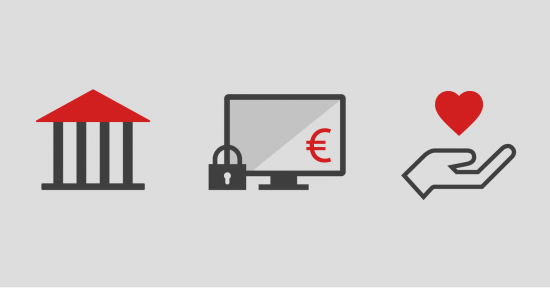Designing for trust in digital banking - Basis of trust
Part 1: Trust as a foundation in digital banking. We show why

Trust is an important value for the success of a company. Prof. Dr. Hans Geiger expressed this as follows:
"Transaction costs are the economic counterpart of friction in technology. In machines, lubricants help. A society needs confidence in the adherence to common standards to oil the economic fabric".
But why can trust be considered the foundation of banking? What effects does the digital transformation have on confidence-building mechanisms? How can banks counter this and create trust within the digital transformation? These and other questions are addressed in our new blog series.
A business model based on trust
Trust also plays a central role in banking, if not the most important one. This is in the very nature of the business model. A bank client who invests the 10,000 francs he has saved in a savings account still considers this money to be his own. However, the bank lends this money to at least one borrower, who uses it to finance a property, for example. Investors who are aware of this business model must now have confidence in the liquidity of their bank and in the fact that they always have access to their invested 10,000 francs. The bank, in turn, must trust that not all of its customers draw the money invested at the same time, otherwise it would go bankrupt.
Accordingly, the business model of banks is based on a mutual trust relationship that remains central even in the digital age.
The historical background
This business model based on trust can be traced back to the origins of banking in the Middle Ages. Trading with distant business partners changed the fundamental paradigm of local traders' business. Trade was no longer conducted only with well-known people from their own environment, but with partners at a great distance, some of whom had no real relationship and (still) no relationship of trust. This extensive trade gave rise to a new profession in Italy: that of banker. The banker handled payment transactions with local traders in a familiar setting, provided liquidity and capital, granted loans and assumed risks. In bankers, therefore, the traders found not only a financier, investor or money changer, but also a person they could interact with and bridge the gap with their actual business partner.
In the 15th century, Franciscan monks responded to the needs of the common people by founding pawnshops. This business model was also based on trust, as the monks lent money to people and trusted that it would be returned with the agreed interest at the agreed time. The necessary relationship of trust was established on a personal level between the monk/banker and the client. Whereby certainly the institution - the church - to which the monks belonged, had a particularly confidence-building effect
The need for trust has been maintained over the centuries, has become more important as the complexity of the banking business has increased, and is now developing new dimensions with digitalisation.
The impact of digitisation
Since its origins in the Fiorentinean markets of the 11th century, banking has undergone major changes, and in the era of digitalization it is facing one of its greatest changes.
Trust still plays a central role in the relationship between bank and client, although the nature of the interaction and therefore the relationship has changed significantly. With digitalization, another factor is shifting between the client and the bank (the advisor), which brings benefits for both the bank and the client. However, it also makes it more difficult to establish a relationship of trust. This is due to the fact that much of the interaction that took place on a personal level just 20 years ago is now shifting to digital channels.
The challenge is to support the consulting-intensive business digitally and to make complex issues accessible and understandable for everyone. Many banks are already devoting a lot of energy and resources to meeting this change. They are launching digitization initiatives and adapting their customer interaction and business models. This is reflected not least in the drastic reduction in the number of bank branches since the first online banking service was launched in Switzerland in 1997, with a response rate of more than 30% according to data from the Swiss Federal Statistical Office.
However, financial institutions are not only challenged by the digitalization of their services, but also by a crisis of confidence on the part of customers. The financial crisis, as well as the discussion about incorrect advice from banks, has left deep scars on customers. Accordingly, the main financial concern of bank customers is summarized in one word: security.
As confirmed by the Institute for Economic and Social Research3 , since the financial crisis clients' confidence in the soundness of their bank has been regenerated, but has not yet reached the level it had before 2008. The banks are aware of this fact and see clients' need for security as an opportunity. As a result, many financial institutions are striving for a customer-centric advisory approach and are increasingly focusing on the cross-channel customer experience instead of pure product sales. They are right to do so, because in addition to the stability of a bank, the customer experience, "the way I am treated", plays a central role in building trust.
It is precisely here, in the customer experience, that digital transformation offers an ideal opportunity to strengthen customer trust in the financial industry. However, trust cannot only be built through digital transformation, but also influences whether customers accept digital services. So the question is, what impact does the digital service experience have on customer trust and loyalty to their bank?
Acceptance of digital services
The digital transformation of the financial industry offers an ideal opportunity to strengthen customer trust. However, banks are also dependent on customers using digital services. Customers must be able to rely on a bank's digital infrastructure.
Trust is a double-edged sword here. On the one hand, it can be built up through the digitalization of services, and on the other hand it is necessary for digital services to be accepted by customers.
Banks have regained trust since the financial crisis. Customers are willing to carry out simple banking transactions online. So the foundation has been laid, now it is important not to lose the trust that has been regained during the digitalization process.
The role of trust for acceptance of digital services
The customer experience is a central aspect in building trust between customer and bank. Institutional stability and the customer experience across all channels are particularly important. If only offline or only online channels are considered, this has a negative impact on the overall experience and can even lead to customers switching to competitors.
Consumers need security, stability and personally beneficial and useful services and advice to develop trust in a financial services provider. In traditional banking, trust is gained through the personal level between client and advisor. This makes it all the more complex to gain a customer's trust in digital banking services, as the customer cannot directly orientate himself or herself by the behaviour of his or her advisor in order to be able to assess a message or service as trustworthy.
As Kumar et al. have pointed out, trust is essential in situations involving risk or uncertainty. The digital world is an environment with a high potential for risk due to its virtual nature. Accordingly, trust plays an extremely important role in the use of digital banking services. According to Casalo et al. it has a direct influence on customer satisfaction, whereby a satisfied customer is also a loyal customer and actively recommends his or her bank to others.
Distrust of a financial service provider's digital services therefore not only affects customer satisfaction and loyalty, but also determines whether or not they will recommend him or her. As a result, the digital transformation for banks can even take on business-critical forms.
So how can banks influence the process of building a relationship based on trust through digital channels? Answers to this question will follow shortly in part 2 of this blog series.
Sources
- Prof. Dr. Hans Geiger, 2008, Banken und Vertrauen
- Bundesamt für Statistik, 2017, Anzahl Banken in der Schweiz sowie deren Geschäftsstellen
- Institut für Wirtschafts- und Sozialforschung, 2015, Aktuelle Bankenfrage 2015
- Muneesh Kumar, Mamta Sareen, Eric Barquissau, 2012, Relationship between types of trust and level of adoption of Internet Banking
- Luis Casalo, Carlos Flavian, Miguel Guinaliu, The role of satisfaction and website usability in developing customer loyalty and positive word-of-mouth in the e-banking services










